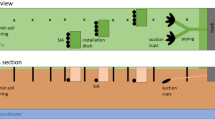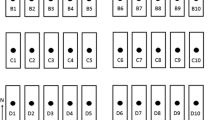Abstract
Monitoring programs of ion concentrations and fluxes in semi-natural ecosystems are confronted with the task to gain as much information as possible with simultaneously minimizing costs and efforts. The aim of this study was (i) to assess how much of the heterogeneity of solution concentrations is lost because of temporal integration of measurements and (ii) to estimate the error in ion fluxes due to temporal integration. High resolution measurements (daily interval) of ion concentrations (sulfate, nitrate, chloride, pH and EC) in throughfall, soil solutions and runoff at the catchment Lehstenbach (Fichtelgebirge, Northeast Bavaria, Germany) were compared over a two year period with the reference monitoring program (biweekly measurement interval). Evaluation of the maximum temporal heterogeneity of ion concentrations in throughfall, soil solution and runoff (expressed as minimum, maximum, median and 25–75% percentile) did not result in an overall higher heterogeneity of the high resolution measurements compared to the reference program. The calculation of runoff fluxes from the reference data (biweekly concentration) resulted in significant errors of up to 25% for time periods < 1 year (high resolution data was considered the "true" value and set as 100%). However, errors became minor (< 10%) if longer time periods were considered. The suitability of different interpolation methods to up-scale biweekly concentration data for the calculation of runoff fluxes was evaluated in this study. We concluded for the monitoring programs at the Lehstenbach catchment that a biweekly measurement interval seemed to be suitable to capture the heterogeneity of ion concentrations and fluxes (and thus temporal trends). In comparison, high resolution measurements with a daily measurement interval were higher in cost, work and time resources and had a relatively low information gain. While the introduced methods are applicable in all monitoring programs, conclusions on temporal resolution of measurements are most likely not valid for systems where ion concentrations have a low autocorrelation length (e.g., agricultural or urban systems with nitrate or pesticide treatment; tropical systems with extreme temperature or hydrological events).
Similar content being viewed by others
References
Bukaveckas P.A., Likens G.E. and Winter T.C. 1998. A comparison of methods for deriving solute flux rates using long-term data from streams in the Mirror Lake Watershed. Water Air Soil Pollut. 1: 277–293.
BML 1997. Dauerbeobachtungsflächen zur Umweltkontrolle im Wald Level II Methodenleitfaden. Bundesministerium für Ernährung, Landwirtschaft und Forsten, Bonn.
Butler T.J. and Likens G.E. 1998. Weekly and daily precipitation chemistry network comparisons in the eastern US: NADP/NTN vs MAP3S/AIRMoN. Atmos. Environ. 32: 3749–3765.
Dirks K.N., Hay J.E., Stow C.D. and Harris D. 1998. High-resolution studies of rainfall on Norfolk Island Part II: Interpolation of rainfall data. J. Hydrol. 208: 187–193.
de Vries W., Reinds G.J., van der Salm C., Draaijers G.P.J., Bleeker A., Erisman J.W. et al. 2001. Intensive monitoring of forest ecosystems in Europe, Technical Report 2001. EC-UN/ECE. Forest Intensive Monitoring Coordinating Institute, Brussels.
Draaijers G.P.J., Bleeker A., van der Veen D., Erisman J.W., Möls H., Fonteijn P. et al. 2001. Field inter-comparison of throughfall, stemflow and precipitation measurements performed within the framework of the Pan European Intensive Monitoring Program of EU/ICP forests. TNO report R 2001/140, UN/CEC-DG6. Netherlands Organisation for Applied Scientific Research, Apeldoorn.
Jenkins A., Ferrier R. and Waters D. 1993. Melt water chemistry and its impact on stream water quality. Hydrol. Process. 7: 193–203.
Kleemola S. and Forsius M. 1997. 6th Annual Report 1997. UN ECE ICP Integrated Monitoring. 6th Annual Report 116. The Finnish Environment Institute, Helsinki.
Larocque M., Mangin A., Razack M. and Banton O. 1998. Contribution of correlation and spectral analyses to the regional study of a large karst aquifer (Charente, France). J. Hydrol. 205: 217–231.
Laudon H. 1999. Spring Flood pH Decline in Northern Sweden: Towards an Operational Model Separating Natural Acidity from Anthropogenic Acidification. Licentiate Dissertation, Umea, Stencil no. 49.
Likens G.E. and Bormann F.H. 1995. Biogeochemistry of a Forested Ecosystem. Springer Verlag, New York.
Lischeid G. 2001. Investigating short-term dynamics and long-term trends of SO4 in the runoff of a forested catchment using artificial neural networks. J. Hydrol. 243: 31–42.
Lischeid G., Alewell C., Bittersohl J., Göttlein A., Jungnickel C., Lange H. et al. 1998. Investigating soil and groundwater quality at different scales in a forested catchment: the Waldstein case study. Nutr. Cycl. Agroecosys. 50: 109–118.
Lischeid G., Kolb A. and Alewell C. 2002. Apparent translatory flow in groundwater recharge and runoff generation. J. Hydrol. 265: 195–211.
Manderscheid B. and Matzner E. 1995. Spatial and temporal variation of soil solution chemistry and ion fluxes through the soil in a mature Norway spruce (Picea abies (L.)Karst) stand. Biogeochemistry 30: 99–114.
Seiler J. and Matzner E. 1995. Spatial variability of throughfall chemistry and selected soil properties as influenced by stem distance in a mature Norway spruce (Picea abies, Karst.) stand. Plant Soil 176: 139–147.
Solo-Gabriele H.M. 1998. Generation of long-term record of contaminant transport. J. Environ. Eng. 124: 619–627.
Stoddard J.L., Jeffries D.S., Lükewille A., Clair T.A., Dillon P.J., Driscoll C.T. et al. 1999. Regional trends in aquatic recovery from acidification in North America and Europe. Nature 401: 575–578.
Stow C.D. and Dirks K.N. 1998. High-resolution studies of rainfall on Norfolk Island Part 1: The spatial variability of rainfall. J. Hydrol. 208: 163–186.
Ulrich B. 1989. Effects of acid precipitation on forest ecosystems in Europe. In: Adriano D.C. and Johnson A.H. (eds), Acid Precipitation: Biological and Ecological Effects (Advances in Environmental Science). Vol. 2. Springer Verlag, Berlin, pp. 189–272.
Wilby R.L., Wigley T.M.L., Conway D., Jones P.D., Hewitson B.C., Main J. et al. 1998. Statistical downscaling of general circulation model output: A comparison of methods. Water Resour. Res. 34: 2995–3008.
Rights and permissions
About this article
Cite this article
Alewell, C., Lischeid, G., Hell, U. et al. High temporal resolution of ion fluxes in semi-natural ecosystems – gain of information or waste of resources?. Biogeochemistry 69, 19–35 (2004). https://doi.org/10.1023/B:BIOG.0000031029.46798.7f
Issue Date:
DOI: https://doi.org/10.1023/B:BIOG.0000031029.46798.7f




